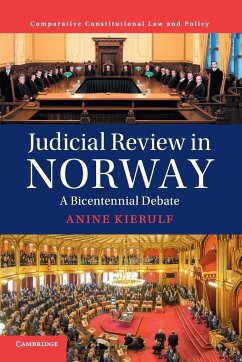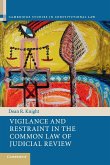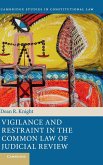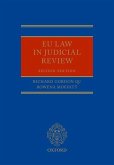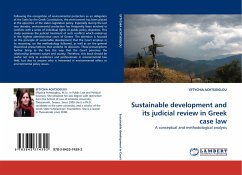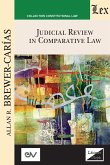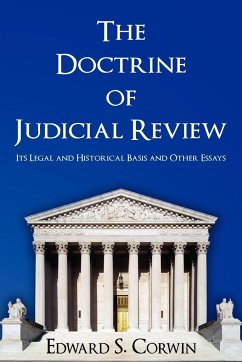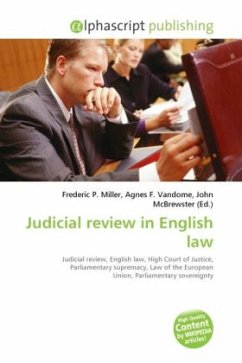Anine Kierulf
Judicial Review in Norway
Andere Kunden interessierten sich auch für
![Vigilance and Restraint in the Common Law of Judicial Review Vigilance and Restraint in the Common Law of Judicial Review]() Dean R. KnightVigilance and Restraint in the Common Law of Judicial Review40,99 €
Dean R. KnightVigilance and Restraint in the Common Law of Judicial Review40,99 €![Vigilance and Restraint in the Common Law of Judicial Review Vigilance and Restraint in the Common Law of Judicial Review]() Dean R. KnightVigilance and Restraint in the Common Law of Judicial Review111,99 €
Dean R. KnightVigilance and Restraint in the Common Law of Judicial Review111,99 €![EU Law in Judicial Review EU Law in Judicial Review]() Richard Gordon QcEU Law in Judicial Review343,99 €
Richard Gordon QcEU Law in Judicial Review343,99 €![Sustainable development and its judicial review in Greek case law Sustainable development and its judicial review in Greek case law]() EFTYCHIA ACHTSIOGLOUSustainable development and its judicial review in Greek case law40,99 €
EFTYCHIA ACHTSIOGLOUSustainable development and its judicial review in Greek case law40,99 €![JUDICIAL REVIEW IN COMPARATIVE LAW. Course of Lectures. Cambridge 1985-1986 JUDICIAL REVIEW IN COMPARATIVE LAW. Course of Lectures. Cambridge 1985-1986]() Allan R. Brewer-CariasJUDICIAL REVIEW IN COMPARATIVE LAW. Course of Lectures. Cambridge 1985-198673,99 €
Allan R. Brewer-CariasJUDICIAL REVIEW IN COMPARATIVE LAW. Course of Lectures. Cambridge 1985-198673,99 €![The Doctrine of Judicial Review The Doctrine of Judicial Review]() Edward S. CorwinThe Doctrine of Judicial Review21,99 €
Edward S. CorwinThe Doctrine of Judicial Review21,99 €![Judicial review in English law Judicial review in English law]() Judicial review in English law23,99 €
Judicial review in English law23,99 €-
-
-
Produktdetails
- Verlag: Cambridge University Press
- Seitenzahl: 326
- Erscheinungstermin: 9. April 2019
- Englisch
- Abmessung: 229mm x 152mm x 18mm
- Gewicht: 474g
- ISBN-13: 9781108445429
- ISBN-10: 110844542X
- Artikelnr.: 57174839
Hinweis: Dieser Artikel kann nur an eine deutsche Lieferadresse ausgeliefert werden.
- Herstellerkennzeichnung
- Libri GmbH
- Europaallee 1
- 36244 Bad Hersfeld
- gpsr@libri.de
Anine Kierulf is Research Director at the Norwegian National Human Rights Institution.
1. Introduction
1.1. Background and context
1.2. Norway in a nutshell
1.3. Review under the constitution - and the ECHR
1.4. Book structure and terminology
2. Legal foundations and doctrinal specifics
2.1. Introduction
2.2. The Norwegian Supreme Court
2.3. The form of and basis for constitutional review
2.4. The basis for ECHR review
3. Foundations reviewed: the formative 1800s
3.1. Outline of a nation constituted
3.2. Courts, lawyers and background for judicial review
3.3. On not losing sight of (some) individuals
3.4. Review discussions prior to the 1866 case
3.5. The 1866 case
3.6. Arguments following 1866
3.7. Liberal constitutionalism defined
4. The emerging regulatory state and a constitutional watershed (early 1900s)
4.1. Constitutional questions arising - and discussed
4.2. The waterfall case
4.3. Legal opinions of 1912 and 1916
4.4. Legal opinions following the 1918 case
4.5. Parliamentary debates on review abolishment
4.6. Constitutional case adjourned
5. Post-WWII: social democratic constitutionalism?: 5.1. Introduction: review revival
5.2. Occupation and post-war adjudication
5.3. Regulatory reconstruction
5.4. Law, politics and history
5.5. Conquer and divide - preparing the expropriation statute
5.6. The Kløfta case
5.7. Kløfta case follow-up
5.8. Judicial review confirmed
6. Debates of ECHR review (1950-2000)
6.1. Introduction
6.2. 'Original intent'
6.3. On ECHR review prior to the HRA - the doctrine of clarity
6.4. Preparations for the human rights act of 1999
6.5. The power and democracy project
6.6. Post-national constitutionalism?
7. Dual review expressed (2000-2010)
7.1. Basis and case selection
7.2. Speech vs personality rights: reputation
7.3. Speech vs policy: political advertising
7.4. Free speech review: a synthesis of ideals?
8. A triple constitutional review revival: 2010
8.1. Prelude
8.2. 2010 Cases
8.3. 2010 Cases Debate and Follow up
8.4. Constitutional review reflections
9. 2014-2015: rights reform - and judicial review constitutionalization
9.1. The 2014 Constitutional Reform
9.2. Judicial review constitutionalization
9.3. Constitutional revitalization
9.4. Dual review constitutionalized
10. Looking back - and forward: 10.1. Legitimacy ideals disentangled
10.2. Political review challenges
10.3. Judicial review challenges
10.4. A bicentennial debate.
1.1. Background and context
1.2. Norway in a nutshell
1.3. Review under the constitution - and the ECHR
1.4. Book structure and terminology
2. Legal foundations and doctrinal specifics
2.1. Introduction
2.2. The Norwegian Supreme Court
2.3. The form of and basis for constitutional review
2.4. The basis for ECHR review
3. Foundations reviewed: the formative 1800s
3.1. Outline of a nation constituted
3.2. Courts, lawyers and background for judicial review
3.3. On not losing sight of (some) individuals
3.4. Review discussions prior to the 1866 case
3.5. The 1866 case
3.6. Arguments following 1866
3.7. Liberal constitutionalism defined
4. The emerging regulatory state and a constitutional watershed (early 1900s)
4.1. Constitutional questions arising - and discussed
4.2. The waterfall case
4.3. Legal opinions of 1912 and 1916
4.4. Legal opinions following the 1918 case
4.5. Parliamentary debates on review abolishment
4.6. Constitutional case adjourned
5. Post-WWII: social democratic constitutionalism?: 5.1. Introduction: review revival
5.2. Occupation and post-war adjudication
5.3. Regulatory reconstruction
5.4. Law, politics and history
5.5. Conquer and divide - preparing the expropriation statute
5.6. The Kløfta case
5.7. Kløfta case follow-up
5.8. Judicial review confirmed
6. Debates of ECHR review (1950-2000)
6.1. Introduction
6.2. 'Original intent'
6.3. On ECHR review prior to the HRA - the doctrine of clarity
6.4. Preparations for the human rights act of 1999
6.5. The power and democracy project
6.6. Post-national constitutionalism?
7. Dual review expressed (2000-2010)
7.1. Basis and case selection
7.2. Speech vs personality rights: reputation
7.3. Speech vs policy: political advertising
7.4. Free speech review: a synthesis of ideals?
8. A triple constitutional review revival: 2010
8.1. Prelude
8.2. 2010 Cases
8.3. 2010 Cases Debate and Follow up
8.4. Constitutional review reflections
9. 2014-2015: rights reform - and judicial review constitutionalization
9.1. The 2014 Constitutional Reform
9.2. Judicial review constitutionalization
9.3. Constitutional revitalization
9.4. Dual review constitutionalized
10. Looking back - and forward: 10.1. Legitimacy ideals disentangled
10.2. Political review challenges
10.3. Judicial review challenges
10.4. A bicentennial debate.
1. Introduction
1.1. Background and context
1.2. Norway in a nutshell
1.3. Review under the constitution - and the ECHR
1.4. Book structure and terminology
2. Legal foundations and doctrinal specifics
2.1. Introduction
2.2. The Norwegian Supreme Court
2.3. The form of and basis for constitutional review
2.4. The basis for ECHR review
3. Foundations reviewed: the formative 1800s
3.1. Outline of a nation constituted
3.2. Courts, lawyers and background for judicial review
3.3. On not losing sight of (some) individuals
3.4. Review discussions prior to the 1866 case
3.5. The 1866 case
3.6. Arguments following 1866
3.7. Liberal constitutionalism defined
4. The emerging regulatory state and a constitutional watershed (early 1900s)
4.1. Constitutional questions arising - and discussed
4.2. The waterfall case
4.3. Legal opinions of 1912 and 1916
4.4. Legal opinions following the 1918 case
4.5. Parliamentary debates on review abolishment
4.6. Constitutional case adjourned
5. Post-WWII: social democratic constitutionalism?: 5.1. Introduction: review revival
5.2. Occupation and post-war adjudication
5.3. Regulatory reconstruction
5.4. Law, politics and history
5.5. Conquer and divide - preparing the expropriation statute
5.6. The Kløfta case
5.7. Kløfta case follow-up
5.8. Judicial review confirmed
6. Debates of ECHR review (1950-2000)
6.1. Introduction
6.2. 'Original intent'
6.3. On ECHR review prior to the HRA - the doctrine of clarity
6.4. Preparations for the human rights act of 1999
6.5. The power and democracy project
6.6. Post-national constitutionalism?
7. Dual review expressed (2000-2010)
7.1. Basis and case selection
7.2. Speech vs personality rights: reputation
7.3. Speech vs policy: political advertising
7.4. Free speech review: a synthesis of ideals?
8. A triple constitutional review revival: 2010
8.1. Prelude
8.2. 2010 Cases
8.3. 2010 Cases Debate and Follow up
8.4. Constitutional review reflections
9. 2014-2015: rights reform - and judicial review constitutionalization
9.1. The 2014 Constitutional Reform
9.2. Judicial review constitutionalization
9.3. Constitutional revitalization
9.4. Dual review constitutionalized
10. Looking back - and forward: 10.1. Legitimacy ideals disentangled
10.2. Political review challenges
10.3. Judicial review challenges
10.4. A bicentennial debate.
1.1. Background and context
1.2. Norway in a nutshell
1.3. Review under the constitution - and the ECHR
1.4. Book structure and terminology
2. Legal foundations and doctrinal specifics
2.1. Introduction
2.2. The Norwegian Supreme Court
2.3. The form of and basis for constitutional review
2.4. The basis for ECHR review
3. Foundations reviewed: the formative 1800s
3.1. Outline of a nation constituted
3.2. Courts, lawyers and background for judicial review
3.3. On not losing sight of (some) individuals
3.4. Review discussions prior to the 1866 case
3.5. The 1866 case
3.6. Arguments following 1866
3.7. Liberal constitutionalism defined
4. The emerging regulatory state and a constitutional watershed (early 1900s)
4.1. Constitutional questions arising - and discussed
4.2. The waterfall case
4.3. Legal opinions of 1912 and 1916
4.4. Legal opinions following the 1918 case
4.5. Parliamentary debates on review abolishment
4.6. Constitutional case adjourned
5. Post-WWII: social democratic constitutionalism?: 5.1. Introduction: review revival
5.2. Occupation and post-war adjudication
5.3. Regulatory reconstruction
5.4. Law, politics and history
5.5. Conquer and divide - preparing the expropriation statute
5.6. The Kløfta case
5.7. Kløfta case follow-up
5.8. Judicial review confirmed
6. Debates of ECHR review (1950-2000)
6.1. Introduction
6.2. 'Original intent'
6.3. On ECHR review prior to the HRA - the doctrine of clarity
6.4. Preparations for the human rights act of 1999
6.5. The power and democracy project
6.6. Post-national constitutionalism?
7. Dual review expressed (2000-2010)
7.1. Basis and case selection
7.2. Speech vs personality rights: reputation
7.3. Speech vs policy: political advertising
7.4. Free speech review: a synthesis of ideals?
8. A triple constitutional review revival: 2010
8.1. Prelude
8.2. 2010 Cases
8.3. 2010 Cases Debate and Follow up
8.4. Constitutional review reflections
9. 2014-2015: rights reform - and judicial review constitutionalization
9.1. The 2014 Constitutional Reform
9.2. Judicial review constitutionalization
9.3. Constitutional revitalization
9.4. Dual review constitutionalized
10. Looking back - and forward: 10.1. Legitimacy ideals disentangled
10.2. Political review challenges
10.3. Judicial review challenges
10.4. A bicentennial debate.

